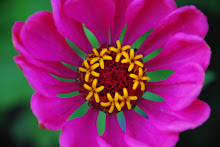June is happily arriving and the garden is full of her colorful vibrant blooms and lush shades of green. Wildlife is everywhere from bees, to butterflies, hummingbirds, and all kinds of other happy critters. I just had my garden certified as a wildlife habitat with the National Wildlife Federation. Fun!
Speaking of garden critters, don't miss my next workshop Organic Gardening to Attract Bees, Butterflies, and Beneficial Bugs Sunday June 3 1pm. Registration & more information here.

My peonies, columbine, delphinium, lupine, rhododendron, and wisteria have just finished their lavish show. Taking center stage now are clematis, poppies, foxglove, catmint, yarrow, spanish lavender, stock, sweet peas, and dianthus. The garden is a delightful explosion of pinks and purples.

Did you notice May was very dry? In fact, it was one of the least rainfall May months we've ever had. I'm not accustomed to watering so much in May and unintentionally let the garden get really dry. Last week I gave a really deep watering to the in-ground garden, raised beds, and containers. Be sure you are staying on top of watering when we receive little to no rainfall. Remember, less frequent deeper watering is more beneficial than frequent shallow watering.
Every day I am harvesting from the edible garden romaine & butterhead lettuce, mesclun mix, mache, collards, lacinato & red russian kale, leaf broccoli, sugar snap peas, snow peas, green garlic, and florence fennel.

Annual edible flowers like calendula and 'lemon gem' marigolds have joined spring-blooming violas with their bright and tasty blooms. Do you have edible flowers in your vegetable garden? If not you are missing out! Join me on Sunday June 3 at 11am for Organic Edible Flower Gardening. Registration and more information here.

Herbs are abundant and I am enjoying the flavors of fresh chervil, dill, lovage, sage, rosemary, oregano, chives, thyme, savory, tarragon, mint, lemon balm, and lemon verbena. A handful of freshly snipped garden herbs adds a welcome layer of taste to my cooking. Stay tuned for more information on a summer organic herb gardening immersion workshop in my own garden this July!

Summer fruit season is highly anticipated. My pale pink strawberries are beginning to ripen, blueberries have set their green fruit, and the raspberries are covered in white flowers announcing what is to come later this summer.

The last week of May ended with night temperatures dipping into the upper 40s, which is no good for tender summer vegetables & herbs like basil, tomatoes, cucumbers, melon, peppers, and corn. Nightly I have been covering up our 2 melon plants. So far the tomato plants seem to have withstood the cooler nights. The cucumber plants look tiny, yellow, and wilted. I think the cold has stunted them so I will purchase new plants and replant the 2nd week in June. I am happy I held off on planting basil. The two basil plants I have are happily living in the sunny bathroom until warmer days.
If you are having any problems with disease, pests, yield or other concerns in the vegetable garden I hope you will join me on Sunday June 10 at 11am for Troubleshooting the Organic Edible Garden. Registration and more information here.
You might wonder if it is too late to plant vegetables and herbs in your garden. It is not! Through the rest of June you can continue to plant all of the following crops:
Basil
Beans
Beets
Carrots
Celery
Corn
Collards
Cucumbers
Eggplant
Gourds
Kale
Lettuce
Melons & Watermelons
Peppers
Potatoes
Pumpkins
Radishes
Scallions/Green onions
Summer Squash
Swiss Chard
Sweet Potatoes
Tomatoes
Tomatillos and ground cherries
Winter Squash
Zucchini
June is still a good time to plant all annual and perennial herbs with the exception of cilantro and chervil that prefer the cooler weather of spring and fall.
Continue planting summer blooming annuals as companion plants to attract beneficial bugs and pollinators as well as provide colorful beauty!
This month as we are turning from spring to summer I think it is too late to plant fruit, as you probably won't get much of a harvest this year. It is too late to start any onions other than scallions/green onions.
As the weather is warming up it is also time to take a break from planting crops that like cooler weather: arugula, asian greens, broccoli, cauliflower, cabbage, cilantro, cress, endive/escarole, fennel, kohlrabi, mustard greens, peas, radicchio, spinach, and turnip.

Its hard to believe but in July and August we will be turning our attention to planting vegetables for a fall and winter harvest!
Enjoy the sunshine and remember to keep the garden watered, unless we've received an ample rain.
I don't know about you, but I am really excited for summer. This spring has been 3 months of frantic busy work for me! Designing, planning, and planting gardens for work and at home. Garden consultation, container installations, teaching classes, speaking at events, and weekly therapeutic horticulture. I am more than ready for the warm, slow days of summer to take a deep breath, put my feet up, savor a glass of garden-fresh herbal iced tea and enjoy sitting peacefully in the garden.
Hoping to see you on June 3 and 10th at Portland Nursery for my free gardening classes and on June 24 for my 2nd annual open garden. Stay posted for more information on gardening workshops I'm offering in my own garden in July and August.
Happy gardening!
Jolie


















